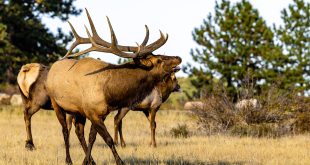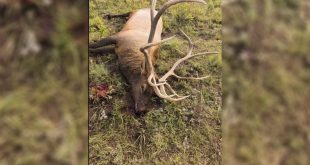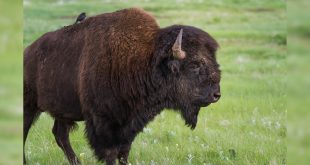Why I Won’t Hunt Mule Deer In Regions G & H
By Scott Reekers
I fancy myself a hardcore mule deer hunter, as most of you who are reading this article likely do as well. I have what I would call a strong collection of public land mule deer hanging on my wall at home and hope that over the next few years I have the ability to add a few more. However, I am not going to be hunting them in my usual spots in western Wyoming this year. Depending on what I find it may not happen for quite some time, we shall see.
This is beyond painful for me to say and for me to think about, but we have to do what is best for the resource. The most recent counts and surveys are suggesting that we had an 80% die off
in the Wyoming Range mule deer herd this past winter. I am going to do my best to throw around some round numbers to show just how dramatic of a drop in population this is for one of the West’s shining gems in the mule deer world.
Before last fall’s hunting season the Wyoming Range herd sat at around 30,000 mule deer total. 40/60 for a buck-to-doe-ratio with the population of bucks being lowered due to hunting season. However, we will stick with the 30,000 number for making these round numbers that are easy to digest while being relatively accurate.
With an 80% die off for adult deer we are looking at having roughly 6,000 mule deer left in the Wyoming Range herd. Let it sink in that 24,000 deer likely perished this winter. And, If I’m honest, this number might be high because fawn mortality is closer to 100%.
The only major change that was made to seasons in Region G and H for residents was to cut a week off of the tail-end of the season. I would argue that cutting time off of the three week season was absolutely necessary, however we should have likely removed the first week of the historical opener, not the last week. I also don’t believe that action alone was nearly enough and I haven’t talked to any serious mule deer hunter in Wyoming who believes it was enough to help course correct the ship.
With that said, seeing the 80% number cemented my plans to not hunt there this year. I have talked with several serious mule deer hunters who have said something along the lines of “Well, it may as well be me hunting them if they are going to keep it a general season.” The problem with that logic is the dependence that these deer, including the big bucks have on generational knowledge that is passed down every year. Mule deer does perform the initial work of teaching the young deer what paths to take along the famous migration routes to Wyoming’s Red Desert. Somewhere around yearling and two year old status the young fork horn and small bucks start to spread their wings and travel back to the high country with the more mature bucks. This is why you see just about every age class of buck that survived a winter doing the hard work of growing antlers together in the high country.
Let me add a disclaimer here as I am about to spend a long time talking about herd health relating to bucks. I am fully aware that the driver of population growth is does and of course their fawn’s survival. However, healthy mature bucks are going to produce more of the same. When the strong breed it produces more strong animals.
Bucks learn to be big bucks from other big bucks. They learn how to become cliff dwellers from the older guys that show them that it is the safest place to get away from predators. The older bucks know where the best feed is during the dry years, they know the most efficient routes to the high country basins that the does rarely make it to. If we want to see our high country basins even more void of bucks than what we see now let’s kill off the few remaining top end age classes.
The principle here is called the “Rose Petal Theory” which I won’t claim to be a biological expert on by any stretch, look to the Wyoming Migration Initiative research to learn all about that as well as our migration video on YouTube. What I have read from their team leads me to believe that it would be VERY unwise for us to kill a large number of bucks this year as it would really disrupt the natural processes for migration that need to happen in regions G and H.
So what should we do to help this herd recover as quickly as possible? Well here are a few solutions that I think would do wonders OVER TIME, and fair warning, a LOT of them won’t be popular. Doing what is right for the resource isn’t always popular but it is necessary so that we will have a huntable population for years to come.
- The first piece of the equation is to protect the most sensitive parcels of the migration corridors. The biggest two needs to address are pinch points created by development and eliminating the gauntlet these deer run on major highway crossings. For both of these situations funding will always be the biggest issue. Every year I make my donation with the renewal of my license plates to the fund that builds over and underpasses, high fences along highways to funnel ungulates through said passes and helps with crucial land acquisition.
- Habitat improvements will always be at the top of the list. A lot of focus is placed on the critical winter range but I would submit that understanding the entirety of their range is more important. Deer put on weight in their summer ranges and then do their best to maintain it through the trials of winter. When we enter prolonged cycles of drought, hard conversations need to be had. Any hunter in the Red Desert has seen the “Wild” horse population explosion. This feral animal population needs to be fixed in a BIG way, right now.
Let’s also call a spade a spade. . . there are a lot of elk living permanently on the winter range that weren’t there 15, 10, even 5 years ago. Despite Wyoming Game and Fish doing their best to bring the herd numbers back down, it’s challenging to say the least. The Red Desert elk herd has grown in a big way and elk simply out compete mule deer. “Wild” horses and elk taking away needed forage from the winter range is not a good combination for mule deer.
We could easily add a section on over grazing here as well. I will submit that it’s hard to get a representative set of data on how much we should or shouldn’t be grazing cattle when we have horses roaming the landscape unchecked. Ranchers are an ally in the horse battle and they need that population brought down too.
- I love that I can buy an OTC mule deer tag in Wyoming every year. The idea that 200 inches is possible every fall makes me go just about crazy during scouting season and I can’t wait for opening day. However, and at the risk of becoming the most unpopular person in Wyoming, I submit that for us to grow the herd back to objective as quickly as possible we will have to open ourselves up to the idea that General seasons aren’t the best way to get there in regions G an H. Here is why, pressure. I know the argument is made that killing bucks doesn’t matter in the long run, what matters is does surviving.
Well, if you have been to the Wyoming Range lately you have heard people talk about the overcrowding issues we seem to have. The data suggests that we have far fewer hunters hitting the hills, which is likely true. Using round numbers again, NR tags have been cut to the lowest ever levels and combined with resident numbers, there are roughly 5-6,000 hunters hitting regions G & H. In the 80s and 90s it was somewhere around triple that. The general tag sales numbers back this trend up too as overall deer tag sales are actually down.
What isn’t down though is hunter days. Our equipment is the best it has ever been and there are more people staying out for longer periods of time. Many residents are now taking the entire month of September off to archery hunt elk and hunt high country mule deer. This turns into pressure. Pressured deer have lower body fat heading into winter which turns into die offs, like the 80% we saw last winter.
I believe we should go down the path of looking at multiple seasons, ask hunters to pick their weapon for mule deer. Make all mule deer hunts a draw, starting with an early September archery season, have a very limited high country rifle season, a little more liberal region wide draw for residents that opens October 1 and ends before rut staging and then an EXTREMELY limited draw for a November rut hunt. Put spaces between each of these hunts to give the deer a break and in turn keep packing on the fat.
- This may be the most important non-habitat related point, we must do MANDATORY harvest reporting. I have driven from one end of the state to the other multiple times and never seen an open checkpoint and sadly there have been years where my surveys were not done. If we can’t apply or have to pay a fine to apply if we forgot to fill out our surveys, can you imagine the power of the data that our biologists would have?
I have been writing the Nevada MRS for years now and I TRUST the data because it is collected via mandatory harvest reporting. By the time the MRS comes out for Nevada it’s a rarity to have less than 90% of the hunter’s reported. I can look at antler data for mule deer and see just how many mature bucks and how many younger bucks were killed. I can also see that tags were cut the next year as a result of too many younger bucks being part of the harvest in a high demand area the year before. I could go on and on. This all comes back to accurate data. We need mandatory reporting to help give biologists in Wyoming the tools they need to set objectives.
- Predator control, this one is easy. If you live in western Wyoming, learn to hunt coyotes and bears. Attend season setting and quota meetings and get bears micromanaged by unit across G & H. A few good bait sites in one area can, and in the past has, been the driving factor in quotas being met for black bears for up to 5 areas. Historically, a LOT of the quota for black bears is met in the Salt River range, which shuts down much of the Wyoming Range for predator hunting before hunters can even get there. It might be more work but what if those 24 females were spread out between all the areas? In one day I saw 5 bears in the Wyoming range during deer season, that year the spring season had been shut down well before any dent could be made on the male population of bears. This one is an easy fix, just needs momentum to get it done!
If you made it this far, thanks for reading and I hope that at the end of the day I believe all of these suggestions could make a difference.
What say you? Do you think that these would help the hurting population?
 Eastmans' Official Blog | Mule Deer, Antelope, Elk Hunting and Bowhunting Magazine | Eastmans' Hunting Journals
Eastmans' Official Blog | Mule Deer, Antelope, Elk Hunting and Bowhunting Magazine | Eastmans' Hunting Journals





100% agree I’ve finally have enough points to draw a nonresident H tag again.but it looks like it will be years until I will come back and hunt your awesome muley country 😥
Thank you for taking the time to inform everyone on the conditions in Regions G & H. As for me, I’m new to Mule deer hunting. Never had a mule deer tag in hand. Being from SC, I grew up hunting whitetail, turkeys, rabbit, alligator, etc., but always dreamed of going out west and hunting big game. So, here I am now, finally able to make it happen and drew a tag for the first time ever in Wyoming and a mule deer tag for the first time ever, in Region H. This will be my third trip out west to hunt, first trip 2020 for elk in Colorado, DIY and came back empty handed, but absolutely loved the experience with my wife and friend which came along for the experience. We hunted the entire week as hard as a 0 Elevation flatlander could physically do. We couldn’t go the next year, but last year, I took a couple guys to assist and went back to Colorado and ended up taking a Cow at the Bottom of a mountain on the last morning. Had some Loin last night from her as a matter of fact… To get on with the point, I drew a tag, never been in Wyoming, never hunted mule deer, and did so not knowing what was completely going on in the region. I plan to drag my old nags, 2000 miles across this country, saddle up with my pastor and go enjoy the experience. If I have the opportunity to take a nice Mule deer buck, I will and will enjoy the moment. If I don’t see one worth shooting, I’m going to make that long dreadful ride all the way back to SC empty handed and enjoy the moment, and learn from my mistakes. Not looking forward to that drive…last trip the truck didn’t shut down for 33 hours straight pulling a 40′ horse trailer to beat the front coming in behind us at the end of 4th season…
100% agree also. I really believe the better data you have , the. better it is for the managers of the wildlife. This will be beneficial for Wyoming and would benefit all states.
Why are you beating up on region G & H? I live in Wyoming and if you do you know the winter’s are brutal. Yes we can always use useful data. You are right on the money for TIME… The department could use a revamp with some increase on fees forsure! Not at 400 or 300 percent. However, I’m sure dedicated hunters would pay the fees to help conservation, I would. Report card kills are important and many others areas need attention as well…OTC tags are given to residents because we are residents… not because a brutal storm came in like always and killed alot of animals. I can go on thx for the article. Lvu see you on the trail. Will lawton. Wy